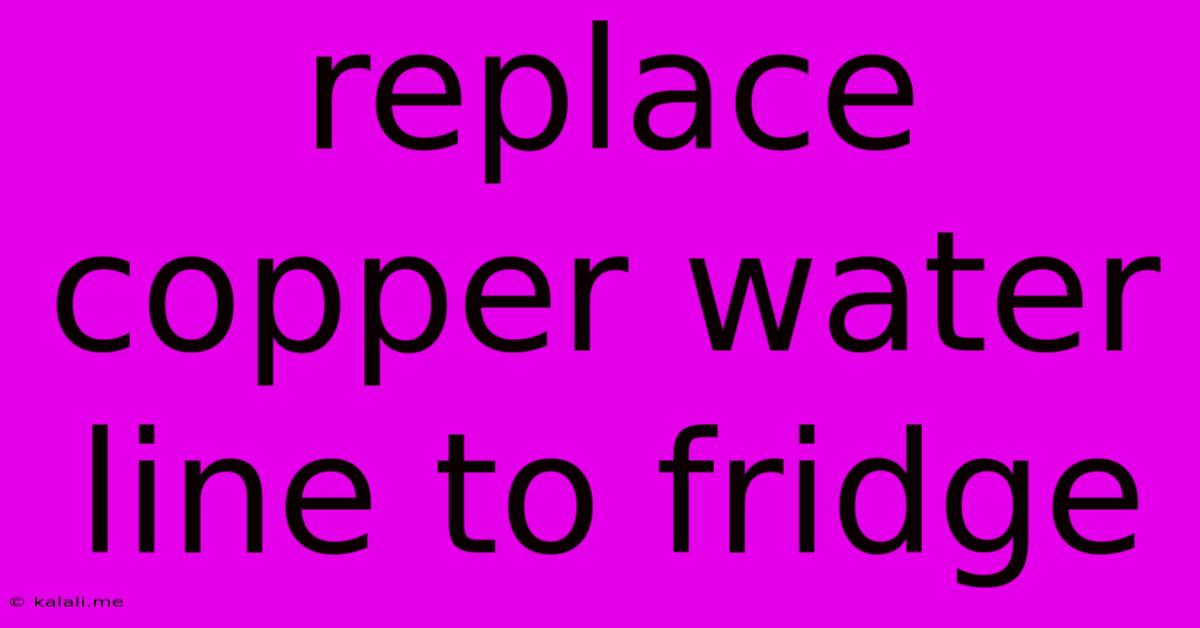Replace Copper Water Line To Fridge
Kalali
Jun 08, 2025 · 3 min read

Table of Contents
Replacing Your Copper Water Line to the Refrigerator: A DIY Guide
Replacing the copper water line to your refrigerator might seem daunting, but with the right tools and a little patience, it's a manageable DIY project. This guide will walk you through the process, saving you the cost of a professional plumber. This process involves turning off the water supply, disconnecting the old line, and installing a new one, ensuring a safe and reliable connection for your refrigerator's ice maker and water dispenser.
Why Replace Your Copper Water Line?
Copper water lines, while durable, can corrode over time, leading to leaks and potentially contaminating your drinking water. A leaking line can also cause significant water damage to your kitchen. Furthermore, older copper lines may not meet current plumbing codes. Replacing the line with a more modern, flexible material offers improved durability and easier installation.
Tools and Materials You'll Need:
- New Water Supply Line: Choose a braided stainless steel line, known for its flexibility and resistance to corrosion. Ensure it's the correct length.
- Adjustable Wrench: To tighten and loosen connections.
- Basin Wrench: Useful for accessing hard-to-reach connections under the sink.
- Pliers: For gripping and manipulating small parts.
- Tubing Cutter: For cleanly cutting the copper tubing (if required).
- Tape Measure: To measure the required length of the new line.
- Bucket or Towels: To catch any spilled water.
- Safety Glasses: Protect your eyes from debris.
- Gloves: Protect your hands.
- Optional: Teflon Tape: For sealing threaded connections (though many new lines come pre-sealed).
Step-by-Step Guide to Replacing Your Refrigerator Water Line:
-
Turn Off the Water Supply: Locate the shut-off valve for your water line under the sink. Turn it clockwise to completely shut off the water supply.
-
Disconnect the Old Water Line: Carefully disconnect the old copper water line from both the shut-off valve and the refrigerator's water inlet valve. Use your adjustable wrench and basin wrench as needed. Have a bucket or towels ready to catch any remaining water in the line.
-
Measure and Cut (If Necessary): If you're using a rigid copper replacement line instead of a flexible one, carefully measure the length needed for the new line using your tape measure. Use a tubing cutter for a clean cut.
-
Connect the New Water Line: Connect one end of the new braided stainless steel line to the shut-off valve, ensuring a tight seal. Hand-tighten initially, then use the adjustable wrench to firmly tighten, avoiding over-tightening. If using Teflon tape, wrap 2-3 turns onto the threads before connecting.
-
Connect to the Refrigerator: Connect the other end of the new water line to the refrigerator's water inlet valve. Again, hand-tighten first, then use the appropriate wrench to secure the connection.
-
Turn the Water Supply Back On: Slowly turn the shut-off valve counter-clockwise to restore the water supply.
-
Check for Leaks: Carefully inspect all connections for leaks. Wipe away any excess water to better see any potential drips. If you see a leak, tighten the connection slightly or replace the seal.
-
Run Water Through the Refrigerator: Run water through the ice maker and water dispenser to flush out the new line and ensure it's functioning correctly. Check for leaks again after this process.
Important Considerations:
- Water Pressure: High water pressure can stress connections. If you have excessively high water pressure, consider installing a pressure regulator.
- Material Choice: Braided stainless steel is recommended for its durability and flexibility. Avoid using materials that are not approved for potable water applications.
- Refrigerator Model: Consult your refrigerator's manual for specific instructions and diagrams. Some models might have slightly different connection points or procedures.
- Professional Help: If you are uncomfortable with any part of this process, it is always best to call a qualified plumber.
By following these steps, you can successfully replace your refrigerator's water line and enjoy a safe and reliable supply of chilled water. Remember safety first, and don't hesitate to seek professional help if needed.
Latest Posts
Latest Posts
-
Does Light Travel In A Straight Line
Jun 08, 2025
-
What Is The Most Electronegative Element
Jun 08, 2025
-
What Bible Was Before The Geneva Bible
Jun 08, 2025
-
Chord Of Calling Vs Spell Queller
Jun 08, 2025
-
How Do We Know If We Are Elect Westminster
Jun 08, 2025
Related Post
Thank you for visiting our website which covers about Replace Copper Water Line To Fridge . We hope the information provided has been useful to you. Feel free to contact us if you have any questions or need further assistance. See you next time and don't miss to bookmark.